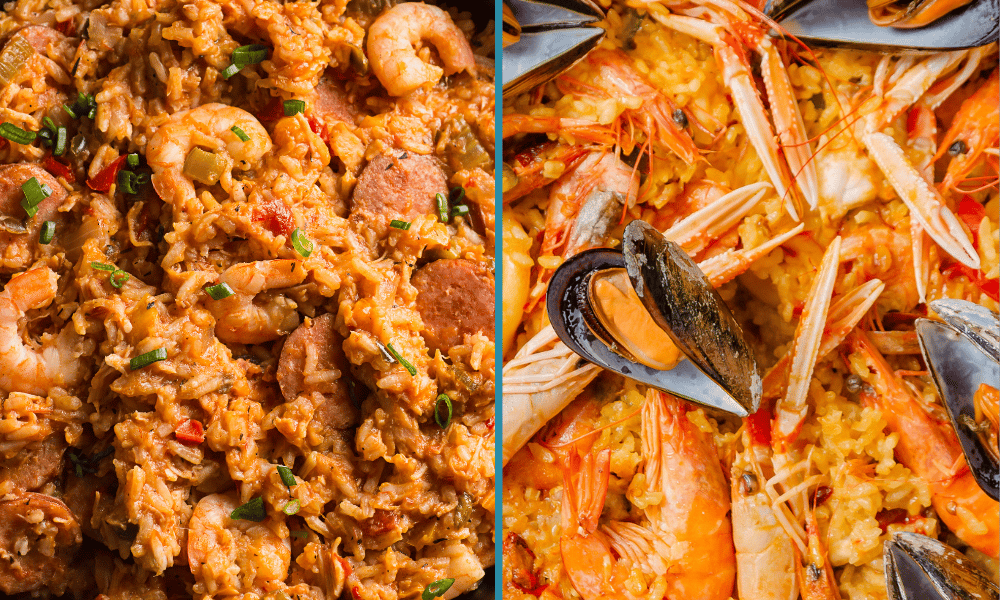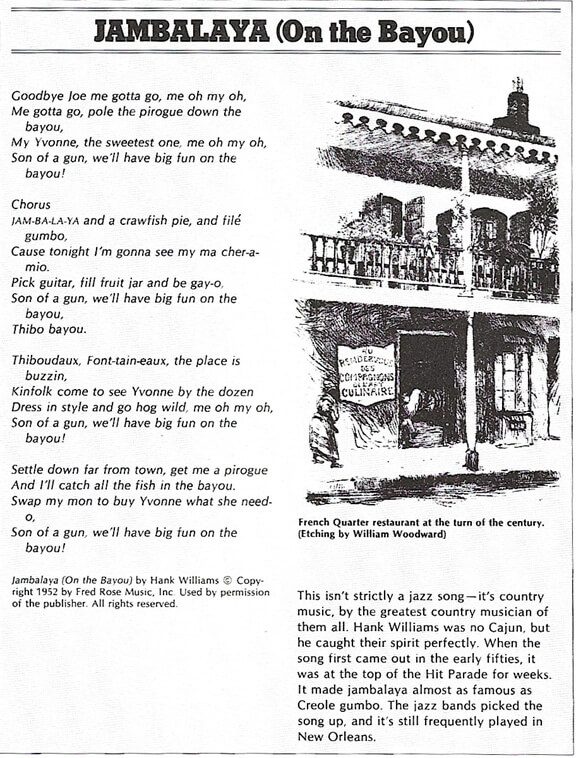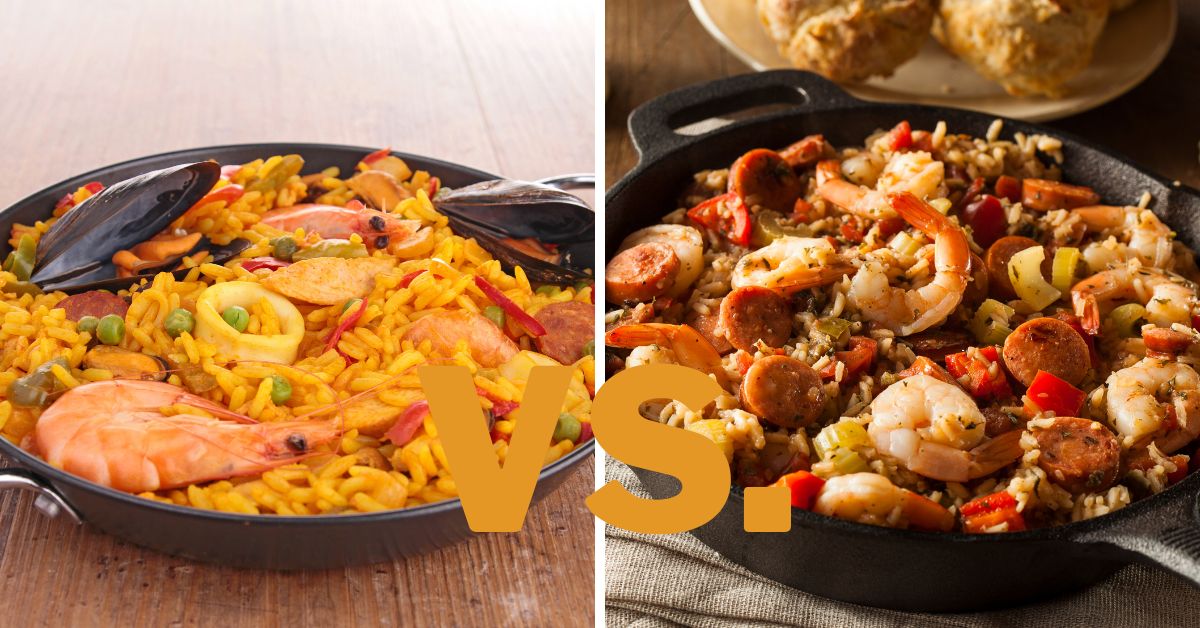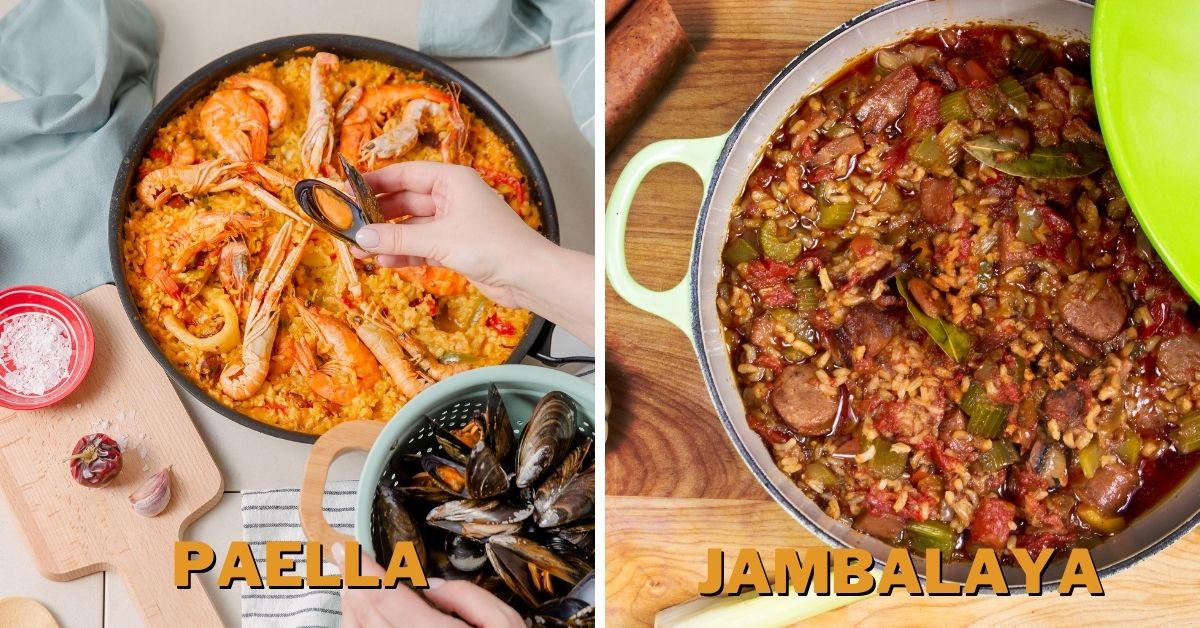
Jambalaya vs Paella What's the Difference? Let's Foodie
Paella is a Spanish rice dish from Valencia, while jambalaya belongs to Cajun and Creole cuisines. Paella uses short grain rice that forms a crust on the bottom. Jambalaya uses long grain rice and is softer. Additionally, paella is yellow in appearance, while jambalaya is either red or brown.

Jambalaya vs Paella Exploring the Key Differences in Flavor and
Jambalaya is a Creole dish from Louisiana. It s made with chicken, sausage, shrimp, andouille a type of smoked pork sausage, tomatoes, bell peppers, onions, celery, green beans, okra, corn, and spices. Both dishes are delicious, but they're also quite different. If you want to enjoy authentic paella, go to a restaurant serving Valencian cuisine.

Seafood Paella vs. Jambalaya A Clash of Coastal Cuisines The Versus Zone
One of the differences between paella and jambalaya is the rice used to make these dishes. Paella is a traditional dish made using a white, short-grained rice. On the other hand, the jambalaya recipe has evolved over the years and uses long-grain rice as its base. Vegetables are added to jambalaya later while cooking to ensure their natural.

Paella Vs. Jambalaya DownInTheKitchen
In a frying (or paella) pan, heat olive oil over medium-high heat. Add chicken and sauté it. Add sausage and sauté, then add your shrimp and sauté it as well. Remove meats from the pan. Now sauté onion and bell pepper. Add tomatoes and garlic as well as saffron and rosemary and garlic cloves. Cook for about 5 minutes.

Paella vs. Jambalaya Differences & Which Is Better?
March 2014. BigGreenCraigdotcom said: There are two basic differences. Types of rice and seasonings. The Paella uses a Spanish short grain rice with saffron and the Jambalaya uses a long grain rice with more of a creole seasoning. Traditional paella should be cooked on a fire, where jambalaya can be cooked stove top.

Paella vs. Jambalaya Differences & Which Is Better?
Exploring The Distinctions Between Jambalaya And Paella. Jambalaya and paella are both popular dishes in their respective regions. They are also both made with rice, which is a staple in many cultures. However, there are some key differences between these two dishes. For one, jambalaya is a Creole dish that originated in Louisiana.

Paella versus Jambalaya — Big Green Egg Forum
What To Know. Jambalaya is a rice dish that originated in Louisiana, while paella is a rice dish that originated in Valencia, Spain. Both dishes are made with rice, but the main difference is that jambalaya is made with a variety of meats, seafood, and vegetables, while paella is made with a specific type of seafood called bomba rice.

Paella Vs Jambalaya A Comparison Of Two Popular Rice Dishes Elmeson
The main difference between jambalaya and paella is the type of rice used. Jambalaya has evolved over the years thanks to a Creole and Cajun influence. Paella is more traditional. It finds its roots in Spain. When making jambalaya, you cook rice in a mixture of broth and meat (usually chicken).

Paella vs. Jambalaya Differences & Which Is Better?
The variations of Jambalaya and Paella reflect the creativity and adaptability of these dishes, which can be customized to suit a wide range of tastes and preferences. Conclusion. In conclusion, Jambalaya and Paella are two delicious rice dishes with distinct differences in flavor and ingredients.

Paella Vs. Jambalaya DownInTheKitchen
Paella vs Jambalaya: The Battle of the Flavors. Now that we've explored the individual charms of paella and jambalaya, it's time to pit these culinary heavyweights against each other in a battle of flavors. From the vibrant colors to the tantalizing aromas, let's dissect the differences and similarities between these two iconic dishes. 1.

Paella Vs. Jambalaya DownInTheKitchen
Jambalaya is made with long-grain rice, while paella is made with short-grain rice. Another difference between the two is the type of meat used. Jambalaya often contains chicken, sausage, and shrimp, while paella often contains chicken, rabbit, and snails. Finally, jambalaya is often served with a side of red beans and rice, while paella is.

Sapodeaux's Paella Jambalaya part I YouTube
Provide examples of dishes inspired by jambalaya or paella. Jambalaya Gumbo: The marriage of jambalaya and gumbo, two iconic dishes of Louisiana, gives birth to a tantalizing fusion known as Jambalaya Gumbo. This delightful amalgamation combines the smoky flavors of jambalaya with the rich roux-based goodness of gumbo, creating a dish that.

Paella vs. Jambalaya Differences & Which Is Better?
Here are some key differences between Jambalaya and Paella: Origin: Jambalaya is a Creole dish that originated in Louisiana, USA, while Paella is a traditional Spanish dish that originated in Valencia, Spain. Rice: The type of rice used in the two dishes is different. Jambalaya uses long-grain rice, while Paella uses short-grain rice.

jambalayavspaella Leaving Work Behind
While both are hearty rice dishes, Jambalaya feels at home in casual, communal feasts, with Paella, in its wide, shallow pan, often shining as the centerpiece of celebratory meals. Jambalaya: A Potful of Cajun Delight. Origin and Cultural Significance: Jambalaya became a sensation in 18th century Louisiana, thanks to Spanish and French influences.

Paella vs. Jambalaya Differences & Which Is Better?
When exploring international cuisine, some dishes appear to be very much alike. A few alterations to the recipe can make it completely different from another, though. This is never more prevalent than in the case of jambalaya and paella. While both look the same, the difference between jambalaya and paella is that jambalaya is a […]

Jambalaya vs Gumbo What Makes Them Different
Jambalaya vs. Paella: Unveiling the Differences. Culinary traditions around the world offer a rich tapestry of flavors and techniques that captivate our taste buds. Among these diverse offerings, jambalaya and paella stand out as two iconic dishes that have captured the hearts and palates of food enthusiasts worldwide. While these dishes may.